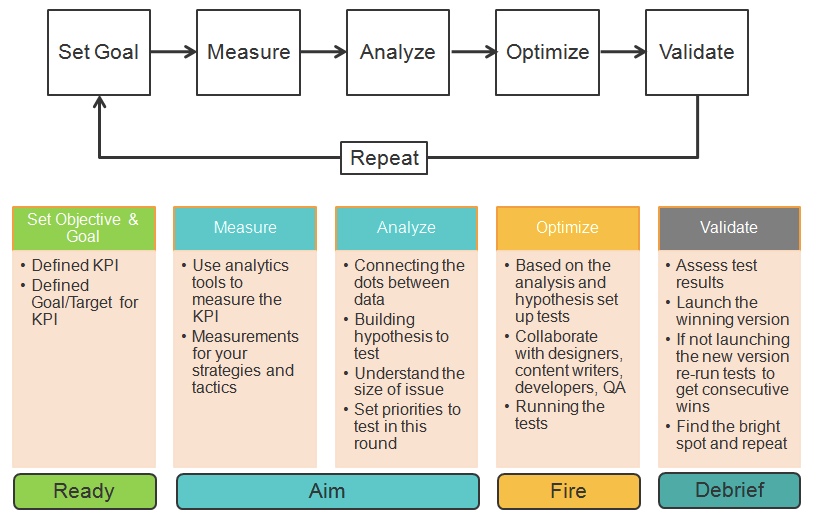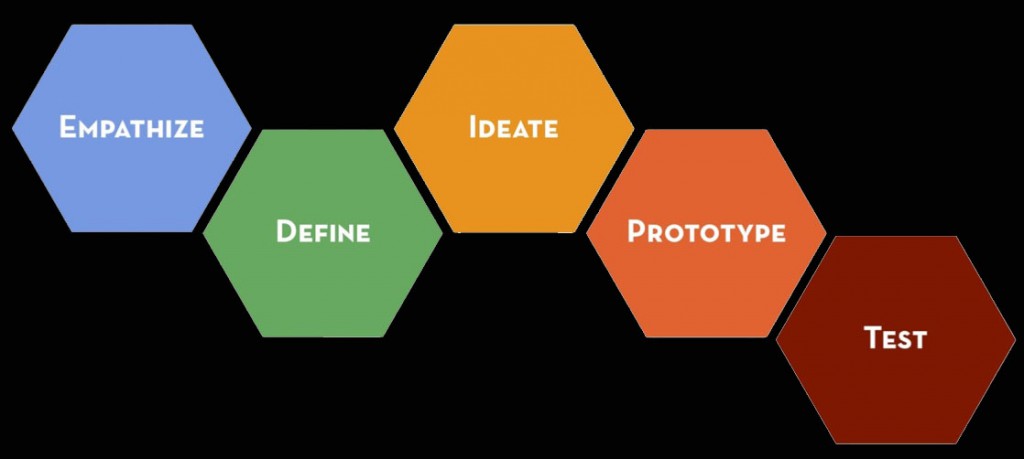
Design thinking process and data driven optimization
As a data person who looks at data to help marketers understand what’s happening on their website or digital marketing programs, it is part of our work to recommend the business on possible next steps and actions to improve the business outcomes.
Going to analytics related conferences and seeing many charts and slides from various experts, it is very common for us to come across data analytics and optimization process diagram.
Usually, those work out really well. It helps us data experts gain a sense of structured process on how to make our data work for our business.

In reality, in the Optimization phase, analytics folks would need to work with web designers, UX expert, engineers, etc. These experts are likely going to work or have different thinking process than analytics experts. I won’t be able to cover the entire subject around design thinking process, but I think it would be very interesting to understand how designers think around solving problems.
I won’t be able to cover the entire subject around design thinking process, but I think it would be very interesting to understand how designers think around solving problems.
A typical scenario of data person handing over insights and recommendation to a designer would end up in some ideation or brainstorming session between analytics person and designer to come up with the test version within the A/B testing practice. If the designer has some knowledge around data and how to optimize, then that is great. It makes many conversations very easy, and great designer would be able to digest the analytical findings and run their designer’s thinking process to come up with some great test design.
If the designer has some knowledge around data and how to optimize, then that is great. It makes many conversations very easy, and great designer would be able to digest the analytical findings and run their designer’s thinking process to come up with some great test design.
This is just my limited view on things, but when I attend A/B testing type meet up or conferences around CRO, I feel like the key designers aren’t there participating at the event. Usually, it is some data expert from marketing division or someone who manages the Optimization team, but not so much of actual producer type of designer.
I feel like in modern marketing, all roles should be involved with data and be part of the optimization process. They should be proactively engaged and participate.
I always wondered how the test designs are generated and introduced as something that may work better than the control. A lot of designers are very opinionated and with full of ideas. It is always interesting to hear what designers articulate and explain their design.
I think the first area of things we analytics people should start to look into is the studies behind the design thinking process.
I’m sure there are many kinds of methodologies, so I’ll just introduce what I found from Stanford University’s d school site and good old Wikipedia. I think by checking out some of these thinking, and be informed would be a great starting point to make collaboration between right brain people and left brain people even better.
Some references to understand design thinking process
Design thinking process links:
http://dschool.stanford.edu/redesigningtheater/the-design-thinking-process/
http://dschool.stanford.edu/our-point-of-view/#design-thinking
http://en.wikipedia.org/wiki/Design_thinking
After checking out some of these sources, let me try to understand the what’s being quoted from one of the sites.
“The Design Thinking process first defines the problem and then implements the solutions, always with the needs of the user demographic at the core of concept development. This process focuses on need finding, understanding, creating, thinking, and doing. At the core of this process is a bias towards action and creation: by creating and testing something, you can continue to learn and improve upon your initial ideas.”
Let’s digest this a bit…
“The Design Thinking process first defines the problem and then implements the solutions, always with the needs of the user demographic at the core of concept development.”
Ok, this is great!! Because data people can help prioritize what the problem is from the data that marketers and designers need to focus on.
“At the core of this process is a bias towards action and creation: by creating and testing something, you can continue to learn and improve upon your initial ideas.”
Awesome!! Isn’t this what the CRO (conversion rate optimization), and data people are trying to do as well? To look at data, create a hypothesis to test, and TEST TEST TEST !!
So it looks like in Stanford’s design thinking process, it consists of these 5 steps:
EMPATHIZE: Work to fully understand the experience of the user for whom you are designing. Do this through observation, interaction, and immersing yourself in their experiences.
DEFINE: Process and synthesize the findings from your empathy work in order to form a user point of view that you will address with your design.
IDEATE: Explore a wide variety of possible solutions through generating a large quantity of diverse possible solutions, allowing you to step beyond the obvious and explore a range of ideas.
PROTOTYPE: Transform your ideas into a physical form so that you can experience and interact with them and, in the process, learn and develop more empathy.
TEST: Try out high-resolution products and use observations and feedback to refine prototypes, learn more about the user, and refine your original point of view.

This is great to know. It looks like to me, the connection with data people and design people need to happen a lot around the ‘Empathize’ and ‘Define’ phase. That is where we may different processes in coming up with a hypothesis.
No wonder designers don’t understand what data people say because designer’s ‘Empathize’ phase could totally be in ‘Optimize’ phase in my earlier diagram, where we’ve defined the hypothesis already. When designers seem to create hypothesis in the ‘Define’ phase.
I may be wrong on some details as many people and processes are different from the various business environment but hopefully, you get the idea.
For me, as a data person, who wants to be a leader in my space, would need to understand how your peers think and solve the problem. This is key to successful collaboration and solving problems together.
Thank you so much for taking the time to read my content. If you've liked what I've had to say please subscribe!
ZoomMetrix Newsletter
Join the newsletter to receive the latest updates in your inbox.